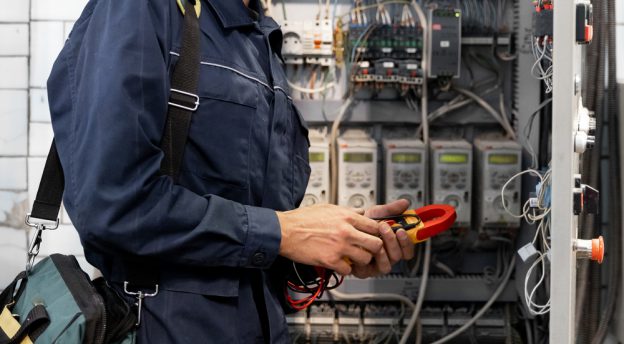 Introduction
Introduction
Like almost every other industry on Planet Earth, the construction industry is witnessing a seismic shift as it embraces the power of artificial intelligence (AI) to revolutionize processes and outcomes.
One of the biggest technological breakthroughs in human history, late 2022 and early 2023 has seen the emergence of AI so sophisticated it is finally becoming widely adopted across industries and business sizes.
The construction industry is no exception to this changing landscape. Several groundbreaking AI technologies are emerging and taking the sector by storm, leading to increased efficiency, enhanced safety, and innovative designs.
Those contractors who don’t adopt AI into their construction pipelines are sure to be left behind – don’t be hopelessly stuck in the past!
In this article, we will help you identify which AI technologies are worth keeping an eye on or even adding to your workflow immediately as a California contractor, so you can gain a competitive edge over your competition.
Types of AI and Use Cases for Construction
Generative Design
AI-driven generative design software is revolutionizing the way architects and engineers approach building design. By inputting specific design constraints and objectives, such as materials, budget, and desired energy efficiency, generative design software rapidly produces a multitude of design options.
This technology operates at lightning speed compared to traditional design – increasing the efficiency of optimizing layouts for structural integrity, cost-effectiveness, and environmental impact, and providing a more sustainable and efficient approach to construction planning.
Autonomous Vehicles
Construction sites are increasingly deploying autonomous vehicles, such as self-driving bulldozers and excavators, to do more precise, more efficient work.
These machines leverage advanced sensors, LIDAR, and GPS technology to perform tasks with minimal human intervention. They significantly improve efficiency and reduce the risk of accidents, contributing to a safer working environment and better allocation of human resources.
Drones
Drones are increasingly becoming commonplace on construction sites, with their ability to seamlessly and easily give a different perspective to your project.
AI-powered drones are becoming an indispensable tool for construction site surveillance and monitoring, allowing you to continue working on other areas of the business while they do their thing without your constant surveillance.
They collect real-time data and generate 3D maps, providing accurate progress reports and identifying potential hazards. Drones also assist in site inspections and reduce the need for manual labor in dangerous or hard-to-reach areas, increasing safety and cost-efficiency.
3D Printing
3D printing has helped revolutionize building in the past decade, and now AI is pushing the capabilities of this process even further.
AI-powered 3D printing technology has made considerable advancements in recent years, enabling the creation of complex architectural structures with precision and speed. This technology reduces waste, minimizes construction costs, and has the potential to revolutionize affordable housing by making the construction of custom designs more accessible.
As 3D printing technology continues to advance, it is expected to play an even more significant role in the construction industry, shaping the way we build our cities and infrastructure with more efficient building materials.
Robotics
From bricklaying robots to robotic arms for welding and cutting, AI-enabled robotics are transforming the construction industry.
These advanced machines perform repetitive and intricate tasks with greater accuracy and speed, improving overall productivity and reducing human error, increasing efficiency and safety at the same time.
The adoption of robotic technology is also expected to enhance the quality and durability of structures, as precise and consistent workmanship becomes the new norm.
Predictive Analytics
The construction industry generates massive amounts of data daily. AI-powered predictive analytics tools harness this data to provide valuable insights into project management and safety.
They can predict potential delays, identify areas of improvement, and develop preventive measures for safety hazards.
With the power of predictive analytics, construction professionals can proactively address challenges and reduce the risk of cost overruns, ensuring that projects are completed on time and within budget. This is an ABSOLUTELY CRITICAL tool for correctly budgeting for costs and calculating your end profit.
Digital Twins
Digital twin technology involves creating a virtual replica of a physical asset or project. These digital representations are updated in real time, allowing construction professionals to monitor project progress, detect issues, and make informed decisions.
By simulating different scenarios, digital twins can help optimize resource allocation, schedule maintenance, and predict potential problems. The integration of digital twins in construction projects is expected to streamline workflows, enhance collaboration, and ultimately lead to higher-quality outcomes.
Wearable Technology
Wearable devices, such as smart helmets and vests equipped with sensors, are enhancing safety and productivity on construction sites.
These AI-driven wearables can monitor workers’ vital signs, track their location, and detect potential safety hazards. Additionally, they facilitate improved communication between team members and offer real-time feedback on work performance. The implementation of wearable technology in the construction industry is poised to significantly reduce the number of workplace accidents, ensuring a safer and more productive environment.
Machine Learning and Building Information Modeling (BIM)
Machine learning algorithms are being applied to Building Information Modeling (BIM) systems to enhance construction processes.
BIM integrates architectural, structural, and engineering data into a single digital model, providing a comprehensive view of the project. Machine learning allows for the automated analysis of BIM data, helping professionals identify patterns and correlations that might have otherwise gone unnoticed. This, in turn, results in more efficient construction processes and optimized decision-making.
AI-driven Project Scheduling and Resource Management
AI-powered software tools are enabling more efficient project scheduling and resource management within the construction industry.
By analyzing vast amounts of historical data, AI can predict the duration and resource requirements for specific tasks, resulting in a more accurate project schedule. This technology also assists in identifying potential bottlenecks and optimizing resource allocation, ensuring that projects are completed efficiently and within budget constraints.
Conclusion
The construction industry is experiencing a paradigm shift as emerging AI technologies pave the way for a safer, more efficient, and innovative future.
As we embrace the AI revolution, the construction industry will continue to evolve and grow, driving progress and prosperity in the built environment.
Embracing these innovative technologies will not only result in improved project outcomes, but it will also create new opportunities for construction professionals within the industry to develop and expand their skillsets – bringing in more value for you while increasing efficiency and the amount of money you can make on each project as your skillsets broaden and deepen.









